Few countries have seen economic transformations like those experienced by Taiwan. Just before World War II, the island was a food exporter of global importance, ranking no. 3 in the world for bananas and canned pineapples. After the 1950s, industrialization was rapid — but many of the products that were money spinners then are now made elsewhere. Services currently account for a greater share of Taiwan’s economy than manufacturing and agriculture combined. Nonetheless, a number of traditional businesses continue to thrive.
GOANG XING PAPER MILL
Located in the northwestern part of Puli Township in Nantou County, Goang Xing Paper Mill (廣興紙寮) has survived the competitive challenge posed by larger, more efficient paper factories by repositioning itself. It’s now both a “tourism factory” (an ugly term for businesses that go beyond manufacturing, and try to educate and entertain visitors) and a supplier of high-end xuan paper (宣紙). This kind of paper can be made from bamboo, rice straw, hemp or other materials. In terms of texture, absorbability and resistance to creasing, it’s ideal for classical Chinese calligraphy.
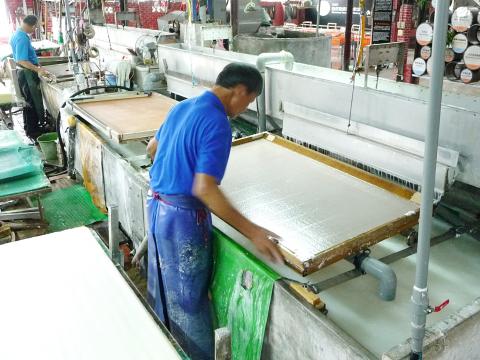
Photo: Steven Crook
The exhibition room displays some specialized tools, but watching the mill’s employees going about their work is much more interesting. One team conjures table-sized rectangles of cream or light brown paper from vats filled with pulpy water. After pressing to get rid of excess water, these sheets are passed to ladies who spread them, one at a time, on a heated metal surface. Using brushes made of pine needles, they skillfully rid each sheet of creases.
The modern building next to the mill has a coffee shop and a store where you can purchase the mill’s artisanal paper products.
Admission to the mill is NT$50 and includes a short guided tour in Mandarin. Tours start every half hour, 9:30am to 11:30am and 1pm to 4pm. If you want to join a DIY activity, get a Chinese-speaker to call (04) 9291-3037 a few days in advance, as not much English is spoken on site. The mill’s Web site, www.taiwanpaper.net, is Chinese only
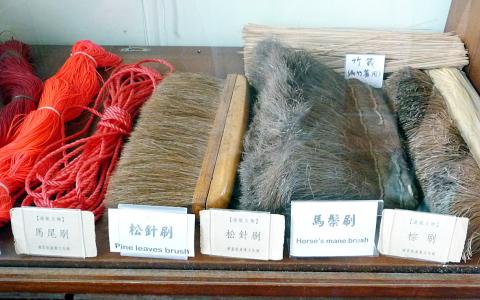
Photo: Steven Crook
The mill’s address is 310 Tieshan Road, Puli Township, Nantou County (南投縣埔里鎮鐵山路310號). The nearest bus stops on Highway 14 are 1.3 km away and served by Taichung-Puli services including bus numbers 6268A, 6268D and 6899.
LU-FANG TAIWAN JADE WORKSHOP
Working with jade is both one of the most ancient art forms in Taiwan and an industry that boomed after World War II, before collapsing within two generations.

Photo: Steven Crook
Jade artefacts were highly valued by the neolithic Beinan culture (卑南文化), which thrived in what’s now Taitung County, over 2,000 years ago. Jade knives and arrowheads from that era are displayed in the National Museum of Prehistory (國立臺灣史前文化博物館) on the outskirts of Taitung City. After many centuries of dormancy, east Taiwan’s jade mines were revived in the early 1960s. Between 1962 and 1986, the island was responsible for more than 50 percent of global nephrite output. (Nephrite is one of two types of jade; the other is jadeite.)
These days, extracting jade from the hills of Hualien is a very minor industry. However, one business continues to turn chunks of nephrite into decorative and ritual items, and its workshop is open to tourists who’d like to try their hand at cutting, carving and polishing.
As soon as you enter the workshop, you’ll see a pile of nephrite and craftsmen busily grinding and polishing. The working environment isn’t nearly so baneful as you might expect: The electric machinery hums rather than roars, and water sprays minimize dust.
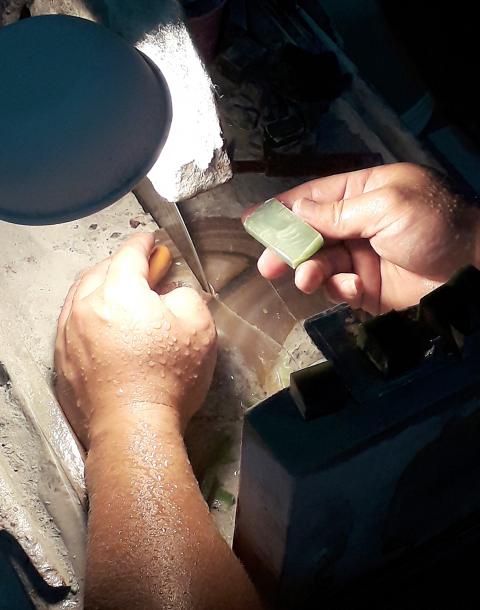
Photo: Steven Crook
For a standard DIY experience, which costs around NT$500 per person, choose a piece of jade from a tray filled with small fragments, then begin — under supervision, of course — shaping and polishing it. You’ll soon realize how difficult it is to craft something attractive, but eventually you’ll have an appealing souvenir.
Lu-Fung Jade Workshop (如豐琢玉工坊) is located at 91 Jhongsiao Street in Hualien County’s Shoufeng Township (花蓮縣壽豐鄉忠孝街91號). It’s open Wednesday to Monday, 9am to 5pm. The Chinese-only Web site is www.taiwanjade.com.tw.
The workshop is less than 1km from Fengtian TRA Station (豐田火車站). Those who visit using their own transportation should approach by Highway 9 and turn off at Jhongsing Street (中興街) or Yutang Road (魚塘路).
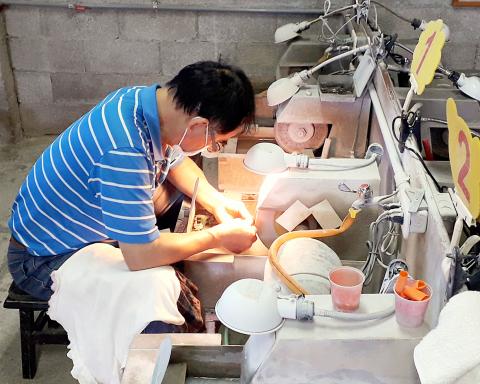
Photo: Steven Crook
SAN-HE TILE KILN
Located on the eastern side of Highway 29, just north of the Old Railway Bridge Wetland Education Zone (舊鐵橋濕地教育園區) in Kaohsiung, San-He Tile Kiln (三和瓦窯; www.sanhetk.com.tw) is the only traditional brick and tile manufacturer still operating in an area that once boasted more than 20 such businesses.
The kilns themselves are easy to spot from the highway. Now over 100 years old and sagging noticeably, these windowless structures look somewhat like abandoned emplacements. The exteriors are marked with soot and stained with damp. Plants and grasses have established themselves in the cracks. But the stacks of new tiles, and the visitors looking at ceramic souvenirs in the shop (open 8am to 5pm daily), are proof that this place is still very active.
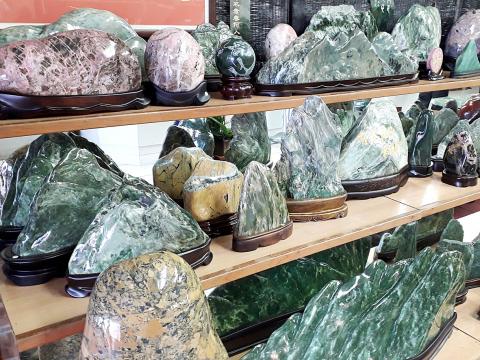
Photo: Steven Crook
Now run by a great-grandson of the entrepreneur who purchased the kiln in 1925, San-He continues to custom-make tiles and bricks for people building temples or restoring sanheyuan (三合院, countryside houses with wings on three sides of a courtyard). Prices depend not only on how many pieces are ordered, but also on the number of molds that have to be made, as each mold has to be handmade.
In the old days, San-He used clay taken from the banks of the Kaoping River (高屏溪), less than 300m from its kilns. Nowadays, clays are sourced from all over Taiwan. After kneading by hand, clods of the raw material are cut into bricks or tiles with a cutting-wire, then dried in special storage building. Unlike most buildings in Taiwan, this low-roofed structure is designed to retain dampness, as unfired items which dry out too quickly tend to be brittle.
There’s an art to loading a kiln. It makes economic sense to pack it as full as possible, yet some spacing is needed so air can properly circulate. Once the stacking is done, a fire is started in front of the kiln. Scorchingly hot air passes between the items being fired, then flows out through small vents at the rear.
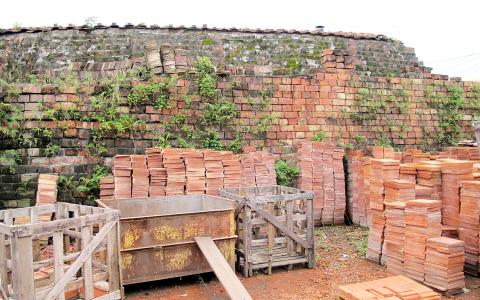
Photo: Steven Crook
Visitors aren’t able to witness the entire manufacturing process, because firing alone takes up to four months. First, waste wood is burned and the temperature inside the kiln reaches 300 degrees Celsius. Then, for at least two months, the fire is fed with rice hulls, pushing the temperature as high as 1,080 degrees Celsius. For the final month, after the fire has died out, the kiln is sealed to retain the heat.
Directions: San-He Tile Kiln is 1.3 km from Jioucyutang TRA Station (九曲堂車站). Bus 8010 takes around 35 minutes to reach the kiln from Dadong Metro Station in Greater Kaohsiung’s Fengshan District (鳳山區). Services are approximately hourly.
Steven Crook has been writing about travel, culture, and business in Taiwan since 1996. Having recently co-authored A Culinary History of Taipei: Beyond Pork and Ponlai, he is now updating Taiwan: The Bradt Travel Guide.
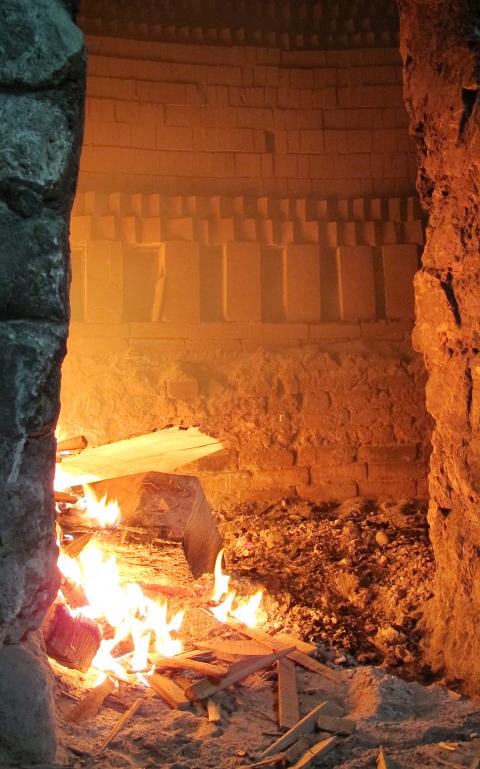
Photo: Steven Crook

May 18 to May 24 Pastor Yang Hsu’s (楊煦) congregation was shocked upon seeing the land he chose to build his orphanage. It was surrounded by mountains on three sides, and the only way to access it was to cross a river by foot. The soil was poor due to runoff, and large rocks strewn across the plot prevented much from growing. In addition, there was no running water or electricity. But it was all Yang could afford. He and his Indigenous Atayal wife Lin Feng-ying (林鳳英) had already been caring for 24 orphans in their home, and they were in

On May 2, Chinese Nationalist Party (KMT) Chairman Eric Chu (朱立倫), at a meeting in support of Taipei city councilors at party headquarters, compared President William Lai (賴清德) to Hitler. Chu claimed that unlike any other democracy worldwide in history, no other leader was rooting out opposing parties like Lai and the Democratic Progressive Party (DPP). That his statements are wildly inaccurate was not the point. It was a rallying cry, not a history lesson. This was intentional to provoke the international diplomatic community into a response, which was promptly provided. Both the German and Israeli offices issued statements on Facebook

Even by the standards of Ukraine’s International Legion, which comprises volunteers from over 55 countries, Han has an unusual backstory. Born in Taichung, he grew up in Costa Rica — then one of Taiwan’s diplomatic allies — where a relative worked for the embassy. After attending an American international high school in San Jose, Costa Rica’s capital, Han — who prefers to use only his given name for OPSEC (operations security) reasons — moved to the US in his teens. He attended Penn State University before returning to Taiwan to work in the semiconductor industry in Kaohsiung, where he

President William Lai (賴清德) yesterday delivered an address marking the first anniversary of his presidency. In the speech, Lai affirmed Taiwan’s global role in technology, trade and security. He announced economic and national security initiatives, and emphasized democratic values and cross-party cooperation. The following is the full text of his speech: Yesterday, outside of Beida Elementary School in New Taipei City’s Sanxia District (三峽), there was a major traffic accident that, sadly, claimed several lives and resulted in multiple injuries. The Executive Yuan immediately formed a task force, and last night I personally visited the victims in hospital. Central government agencies and the